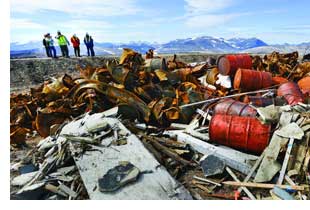Federal Facilities:
 The
cleanup and transfer process for bases depends largely on the type of military installation. In general, there are three
types of bases: Formerly Used Defense Sites (FUDS), Base Realignment and Closure (BRAC) sites, and active bases. The following
document lists the characteristics of each:
The
cleanup and transfer process for bases depends largely on the type of military installation. In general, there are three
types of bases: Formerly Used Defense Sites (FUDS), Base Realignment and Closure (BRAC) sites, and active bases. The following
document lists the characteristics of each:Types of former Military Bases [pdf]
Contamination at FUDS is typically addressed by the Department of Defense (DoD) through an environmental program that congress established in 1986: the Defense Environmental Restoration Program. In order to address tribal concerns in DoD environmental programs, Congress has appropriated annual funding to mitigate environmental impacts on Indian Lands and Alaska Native Claims Settlement Act (ANCSA) – conveyed properties since 1993. In 1996, DoD developed the Native American Lands Environmental Mitigation Program (NALEMP) to work closely with tribes to mitigate environmental impacts with maximum tribal participation. DoD oversees efforts to gather information concerning potential environmental impacts, assess each impact for eligibility in the program, prioritize impacts for mitigation, and consult with the affected tribes.
The Native American Lands Environmental Mitigation Program (NALEMP) was developed in 1996 by the Department of Defense (DoD) to address environmental issues from past DoD activities on Indian lands, including Alaska Native Claims Settlement Act conveyed lands and Native allotments. The program provides tangible stake to Tribes in project decision-making on matters important to them, develops tribal capacity regarding environmental remediation activities beyond the immediate project, and develops/fosters valuable partnerships between sovereign nations and DoD. Funding is available for:
- Training & technical assistance to tribes
- Related administrative support
- The gathering of information
- Documenting of environmental damage,
- System for prioritization of mitigation
- Cost to complete estimates for mitigation
NALEMP has typically funded the removal of hazardous materials on Native-owned lands, including:
- Abandoned drums, old equipment, and debris
- Unsafe buildings and structures
- Unexploded ordnance
For example, DoD debris in Elson Lagoon has resulted in navigational hazards to tribal subsistence hunters and fishermen. Additionally fishing nets have been snagged, torn, or lost due to the debris. Therefore, NALEMP funded removal of this debris.
DoD's annual report to Congress in 2009 summarizes their efforts and describes the cooperative agreements that they enter into with tribal governments to address environmental problems attributable to past DoD activities.
Types of former Military Bases [pdf]
DoD's plan of action to implement the policies and directives of Executive Order 13175, Consultation and Coordination with Indian Tribal Governments, January 2010 is as follows:
Types of former Military Bases [pdf]
Note that although a site is a FUDS, this does not necessarily mean that DoD is a responsible party for cleanup, nor the sole responsible party. See EPA’s policy towards privately-owned FUDS:
Types of former Military Bases [pdf]
Native American Management System for Environmental Impacts (NAMSEI) is an online system that allows tribal representatives, DoD, and the public to access, report, and share information on DoD-related issues of concern. It also tracks and maintains information on potential impacts to tribal lands and resources resulting from DoD activities. NAMSEI provides a historical record of site assessment results, presents a forum to report new suspected impacts, and receives online comments about assessments and project status updates. Additionally, the system supports program planning and funding decisions related to NALEMP.
Contaminants of Concern:
Each federal facility site will have different contaminants of concern. Most can be found searching online for fact sheets associated with each site. Common contaminants associated with federal facilities include radiological contamination, solvents, fuels, asbestos, metals, polychlorinated biphenyls (PCBs) and munitions/explosives.Sites such as the USDOE Savannah River Site are complex and include uranium, arsenic, mercury, cesium, radium, thorium, benzo(a)pyrene, cobalt, lead, chromium, and potassium. This site was used in the 1950s to produce basic materials used in the fabrication of nuclear weapons, including reactors, support facilities, chemical separation plants, heavy water extraction plant, nuclear fuel and target fabrication facility, and waste management facilities.
Contamination resulting from past ammunition manufacturing operations at the Twin Cities Army Ammunition Plant has been identified in groundwater, soil, sediment and surface water. Contaminants of concern include chlorinated solvents, explosives, metals, VOCs, SVOCs, PCBs, PAHs and lead. The primary contaminants of concern in the groundwater both on and off-site are VOCs. The contaminants in the soil on TCAAP primarily consist of VOCs and lead. The contaminated sites that are being addressed by the Army consist of ground and surface water, surface disposal areas, sediments, disposal pit/dry well, landfills, chemical disposal areas, firing ranges, small arms ranges, unexploded munitions/ordnance and burn areas.
Sources for contaminants include:
Diesel-powered electric generators
Batteries
Controlling equipment
Diesel fuel storage tanks
Metal surfaces covered with a waterproof coating containing PCBs to prevent corrosion
Metal cleaning operations (concrete settling pits)
The Federal Facilities Restoration and Reuse Office (FFRRO) has developed fact sheets that address emerging contaminants of particular concern to the federal facility community. These are available at http://clu-in.org/emergingcontaminants/
Implementing Solutions:
Please submit your experiences (successes/challenges) and tribal-specific documents to share on our website using the attached form.Download Form
Resources:
FUDS Acronyms and Glossary [pdf]NALEMP Overview Powerpoint 2006 [pdf]
Services, LLC Guidance and Implementation to assist with NALEMP projects [pdf]
Websites:
Department of Defense Environment, Safety and Occupational Health Network and Information Exchange: Native American Affairs:www.denix.osd.mil/na/home/
Formerly Used Defense Sites:
www.usace.army.mil/Missions/Environmental/Formerly-Used-Defense-Sites/
Native American Lands Environmental Mitigation Program (NALEMP):
www.denix.osd.mil/na/nalemp/
Related Pages:
Abandoned Drums, Old Equipment, DebrisAbandoned/Unsafe Buildings and Structures
Alaska Case Study
Contaminated Sites
Unexploded Ordnance
Unsafe Structures in Bays/Oceans/Rivers
For more information, please contact:
Jennifer Williams, Alaska Program Coordinator, Sr.
Tel: 928/523-0673
Email: Jennifer.Williams@nau.edu
Tel: 928/523-0673
Email: Jennifer.Williams@nau.edu
Last updated: July 10, 2015
